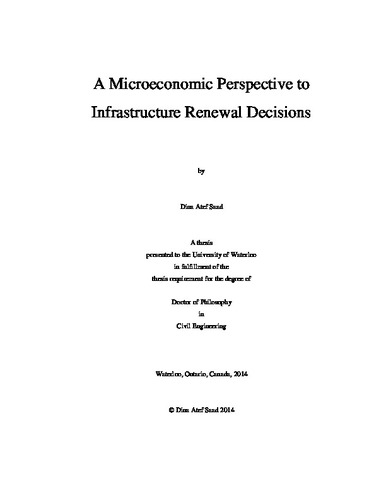| dc.contributor.author | Saad, Dina | |
| dc.date.accessioned | 2014-12-16 19:47:45 (GMT) | |
| dc.date.available | 2014-12-16 19:47:45 (GMT) | |
| dc.date.issued | 2014-12-16 | |
| dc.date.submitted | 2014 | |
| dc.identifier.uri | http://hdl.handle.net/10012/8998 | |
| dc.description.abstract | Under the prevailing financial constraints and rapid infrastructure deterioration, funding decisions for renewal (rehabilitation) projects have become large challenges for engineers and economists alike. However, existing prioritization and ranking methods suffer from serious drawbacks of not considering multi-year and multi funding scenarios. Moreover, optimization efforts in the literature employ sophisticated mechanisms without providing a structured strategy or justification behind the funding solution. To overcome these drawbacks and to arrive at optimum and economically justifiable infrastructure funding decisions, this research provides a decision support system by adopting well-established concepts from the science of Microeconomics that relate to Consumer Theory and Behavioural Economics. The new decision support system has been developed with two components: (1) an enhanced benefit-cost analysis (EBCA) heuristic approach that arrives at optimum decisions by targeting equilibrium among the different renewal expenditure categories, using the equal marginal utility per dollar concept; and (2) a visual what-if analysis inspired by the indifference maps concept to study the sensitivity of decisions under different budget levels. The developed decision support system has been validated through a number of case studies including a case study were different categories of assets (pavements, bridges) are co-located. The results proved the capability of the system to arrive at optimum funding decisions supported with economic justification. Using the behavioural economic concept of “Loss-aversion”, this research also compared the strategy of minimizing loss against the typical strategy of maximizing gain in the infrastructure funding decisions. In essence, this research is aiming at improving this crucial infrastructure funding problem by integrating the two worlds of microeconomics and asset management. Such integration will help provide optimum funding decisions, increase the credibility of funding methods to the public, and justify the spending of tax payer’s money on infrastructure rehabilitation projects. | en |
| dc.language.iso | en | en |
| dc.publisher | University of Waterloo | en |
| dc.subject | Infrastructure rehabilitation/renewal | en |
| dc.subject | Optimization | en |
| dc.subject | Fund-allocation | en |
| dc.subject | Marginal utility per dollar | en |
| dc.subject | Microeconomics | en |
| dc.subject | Benefit-Cost (Cost-Benefit) | en |
| dc.subject | Equilibrium | en |
| dc.title | A Microeconomic Perspective to Infrastructure Renewal Decisions | en |
| dc.type | Doctoral Thesis | en |
| dc.pending | false | |
| dc.subject.program | Civil Engineering | en |
| uws-etd.degree.department | Civil and Environmental Engineering | en |
| uws-etd.degree | Doctor of Philosophy | en |
| uws.typeOfResource | Text | en |
| uws.peerReviewStatus | Unreviewed | en |
| uws.scholarLevel | Graduate | en |

